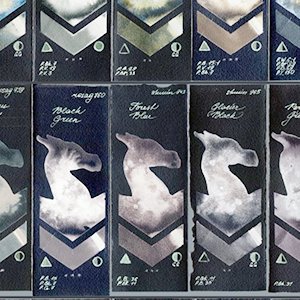White watercolors swatches
created at: 2019-12-09
modified at: 2025-11-15
What is white as a color?
A brief history of white pigments in oils and watercolors
Titanium PW6 vs. Zinc White PW4 — what’s the difference?
Why don’t we use Lead White (PW1) anymore?
What makes a pigment so white? Is Titanium White bleached?
What is Unbleached Titanium PW6:1?
Why is using white in watercolor considered mauvais ton?
How to use white and other opaque pigments without losing that watercolor feel?
White watercolors swatches

What is white as a color?
White isn’t a color in the traditional pigment sense — it’s the absence of hue, but full of light. In watercolor, it’s often not needed at all, since the paper itself serves as the source of white. Still, white pigments have their place when used thoughtfully.
A brief history of white pigments in oils and watercolors
White pigments have been used for centuries — in both oil and watercolor. In the past, artists relied heavily on Lead White (PW1), which offered great opacity, fast drying time in oils, and a slightly warm tone.
Later, safer alternatives were introduced: Zinc White (PW4) came into use in the 19th century, followed by Titanium White (PW6) in the 20th century. These modern whites replaced lead due to toxicity concerns.
Later, safer alternatives were introduced: Zinc White (PW4) came into use in the 19th century, followed by Titanium White (PW6) in the 20th century. These modern whites replaced lead due to toxicity concerns.
Titanium PW6 vs. Zinc White PW4 — what’s the difference?
Titanium White (PW6) is more opaque and much stronger in tinting strength. It can easily overpower a mix.
Zinc White (PW4), on the other hand, is more transparent and subtle — it lightens colors gently without overwhelming them. Some manufacturers even blend the two for a balanced effect.
Zinc White (PW4), on the other hand, is more transparent and subtle — it lightens colors gently without overwhelming them. Some manufacturers even blend the two for a balanced effect.
Why don’t we use Lead White (PW1) anymore?
Lead White was once a favorite, especially in oil painting, due to its warm tone and unique handling. But it's highly toxic. Prolonged exposure can cause serious health issues, so it’s now banned or restricted in many countries. Safer alternatives like Titanium and Zinc have taken its place.
What makes a pigment so white? Is Titanium White bleached?
Titanium white pigment (PW6), also known as titanium dioxide (TiO2), is not bleached. It is inherently a bright white pigment due to its high refractive index and ability to scatter light, not because of a bleaching process.
The white color is a result of the titanium dioxide's chemical structure, which causes it to reflect and scatter visible light.
It can have impurities, so it’s refined and processed to reach that brilliant whiteness.
The white color is a result of the titanium dioxide's chemical structure, which causes it to reflect and scatter visible light.
It can have impurities, so it’s refined and processed to reach that brilliant whiteness.
What is Unbleached Titanium PW6:1?
Unbleached Titanium is a variation of regular Titanium White that includes a small amount of iron oxide. This gives it a warm, sandy hue — sometimes leaning toward pink, yellow, or even green depending on the blend.
You can even mix your own by blending bleached Titanium with a touch of any warm iron oxide pigment. In general, mixing dark or warm pigments with white often creates lovely muted tones.
It pairs beautifully with earth tones like Sienna, Umber, and Ochre, lightening them without dulling their character. Unbleached Titanium is also commonly referred to as Buff Titanium, and it’s a favorite for gentle, natural-looking mixes.
You can even mix your own by blending bleached Titanium with a touch of any warm iron oxide pigment. In general, mixing dark or warm pigments with white often creates lovely muted tones.
It pairs beautifully with earth tones like Sienna, Umber, and Ochre, lightening them without dulling their character. Unbleached Titanium is also commonly referred to as Buff Titanium, and it’s a favorite for gentle, natural-looking mixes.
Why is using white in watercolor considered mauvais ton?
Because one of watercolor’s main appeals is its transparency and glow. Opaque pigments like white can make a painting look chalky or pastel-like. They block the light, flatten the color, and take away that crisp clarity watercolor is known for.
Even a small amount of white in a mix can make the color feel dull or matte instead of vibrant and ringing.
Even a small amount of white in a mix can make the color feel dull or matte instead of vibrant and ringing.
How to use white and other opaque pigments without losing that watercolor feel?
Use white in diluted washes — this helps maintain transparency and keeps the painting looking fresh. Don’t overwork the paint; let it flow and settle on its own.
If you apply a thick, opaque white or pastel color, try to use it in the final stages of your painting. Don’t layer over it — once it’s dry, it should act like the top note of a melody, not the base.
If you apply a thick, opaque white or pastel color, try to use it in the final stages of your painting. Don’t layer over it — once it’s dry, it should act like the top note of a melody, not the base.

